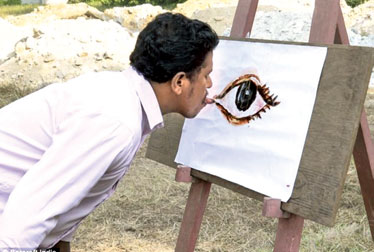|

Meet the lady with the beard
Twenty-three- year old Harnaam Kaur of Slough, Berkshire, UK, is a
courageous woman who is growing a beard like a man.
 Suffering from polycystic ovary syndrome, which can cause excessive
hair growth, Harnaam was just 11 years when a beard started to appear on
her face and the hair quickly spread to her chest and arms. Suffering from polycystic ovary syndrome, which can cause excessive
hair growth, Harnaam was just 11 years when a beard started to appear on
her face and the hair quickly spread to her chest and arms.
The condition made her the victim of cruel taunts at school and on
the street.
She even received death threats from strangers over the internet.
After being baptised as a Sikh - a religion where it is forbidden to cut
body hair, she said: "I would never ever go back now and remove my
facial hair because it's the way God made me and I'm happy with the way
I am. "I feel more feminine, more sexy and I think I look it too.
"I've learned to love myself for who I am, nothing can shake me now."
During her early teens, Harnaam was so ashamed of her beard that she
resorted to waxing twice a week. She also tried bleaching and shaving.
At her lowest points she began self-harming and she even considered
taking her own life. She said: "I got bullied badly - at school I was
called a 'beardo' and things like 'shemale' and 'sheman.'
 Despite often being mistaken for a man, Harnaam says she feels more
feminine than ever - choosing girly tops over baggy, high-necked
jumpers. Despite often being mistaken for a man, Harnaam says she feels more
feminine than ever - choosing girly tops over baggy, high-necked
jumpers.
She said: "I'm able to go out and shop in the women's section without
feeling I shouldn't be there.
"I wear skirts, dresses and jewellery and I like to get my nails done
like every other girl."
Today Harnaam hopes her story will help other women find
self-confidence. She is also confident that someone would accept her
truly.
"I understand certain people won't be attracted to me but there are
so many people in the world and I hope there's someone out there who
will accept me."
Indian artist uses tongue in over 1,000 paintings
When you work on a painting you normally use a paintbrush to mix
colours and also use it the appropriate place in your creation.
But can you imagine a painter using his own tongue to mix the paint
and apply in the correct place!
 For 35-year-old Kerala-based school teacher, Ani K it is his own
tongue which is used as the paint brush for his over 1,000 paintings. He
also claims to use non-toxic watercolours. For 35-year-old Kerala-based school teacher, Ani K it is his own
tongue which is used as the paint brush for his over 1,000 paintings. He
also claims to use non-toxic watercolours.
Included in Ani K's roster of art: an eight-foot version of the
Leonardo da Vinci's The Last Supper, and portrait of Jesus Christ
created entirely using the swirling and persistent strokes of his
tongue.
"I wanted to be a different kind of artist," he says by way of
explanation in the above video.
But he didn't jump straight to the tongue.
"I have tried painting with my nose, tried painting with my chin, my
elbows and feet," the 35-year-old said. "I also tried drawing with both
hands simultaneously, and also while riding on a moving bike."
The tongue, in the end, would serve Ani K, though not without a
price. "After painting with my tongue, I experience pain in my jaws,
headaches, slight loss of vision and dip in memory power," he says. "The
side effects stay around for two week.
With a slip of his tongue, Ani K has painted more than 1,000 works -
including an eight-foot da Vinci and a portrait of Jesus Christ. Keeping
it classic in some ways at least.
If the tongue won't lead Ani K to stardom, there are other ways. "For
the Guinness Records," he says, "I am going to paint four portraits
using both hands and both feet at the same time."
Beware of tree-climbing crocodiles
If you want to take a dip in a river the first thing you must check
is whether there are crocodiles roaming around in the water. There have
been many incidents where men, women and children have been dragged into
the water and killed by these silent killers.
Crocodiles are usually considered ground-dwellers and sometimes wade
in the water.
 But now it has been discovered four species of crocodiles are able to
climb trees. According to Vladimir Dinets, a research assistant
professor in the Department of Psychology, University of Tennessee.
Knoxville, there are four species of tree climbing crocodiles on three
continents - Australia, Africa and North America. But now it has been discovered four species of crocodiles are able to
climb trees. According to Vladimir Dinets, a research assistant
professor in the Department of Psychology, University of Tennessee.
Knoxville, there are four species of tree climbing crocodiles on three
continents - Australia, Africa and North America.
Dinets and colleagues decided to pin the phenomenon down. In the
course of conducting their crocodile research, the scientists kept sharp
eyes out and recorded their observations of climbing crocs.
Examining previous studies and anecdotal observations they found that
these crocodiles climbed trees - usually above water - but how far they
ventured upward and outward varied by their size.
In Australia, they observed freshwater crocodiles basking on
low-hanging branches day and night. When approached by boats, the crocs
splashed into the water below to escape. Climbing Aussie crocodiles were
more likely to be small or juvenile; hatchlings are sometimes able to
cling to brickwork and escape crocodile farms.
In the Americas, Dinets observed crocs as long as three feet (1 m)
sunning themselves on mangrove roots and branches. Most of the time, the
creatures were found no more than three feet (1 m) up. Dinets never saw
any crocs in the process of climbing, just at their destinations, and
when approached, the animals in trees always jumped or fell into the
water.
"This shyness might explain why tree-climbing behaviour in crocodiles
remains relatively little known despite being relatively common," the
researchers explained. Dinets said crocodiles lack the toe and foot
structure that would be expected of a climber. However, smaller and
juvenile crocodiles in particular were observed climbing vertically
while larger ones tended to climb angled trunks and branches, all of
which is a measure of the reptiles' spectacular agility, he said.
"They just go slowly," he said. "Eventually they get there."
The researchers believe the crocodiles climb to keep a lookout on
their territory and to warm themselves in the sun.
"The most frequent observations of tree-basking were in areas where
there were few places to bask on the ground, implying that the
individuals needed alternatives for regulating their body temperature,"
the authors wrote.
The champion climbers of the crocodiles seem to be Central Africa's
slender-snouted species, which regularly bask up high, the researchers
found.
One of these crocs, 4.5 feet (1.4 m) long, was seen roosting at the
end of a fallen tree.
To get there, it would have had to scale a 13-foot-tall (4 m)
vertical bank and then crawl 13 feet (4 m) out on a sloping branch.
The largest tree-climber observed was a Nile crocodile 6.5 feet (2 m)
seen basking a foot and a half (0.5 m) above water on a fallen branch in
Botswana.
We Sri Lankans are not threatened yet, but if one of the tree
climbing crocs decide to "immigrate" to Sri Lanka we too will have to
look up while bathing in rivers. |

